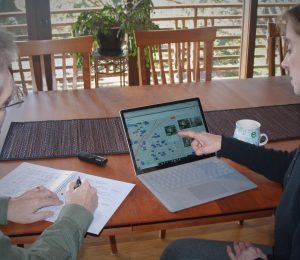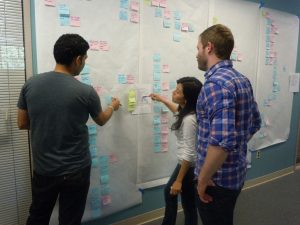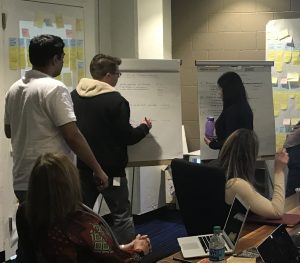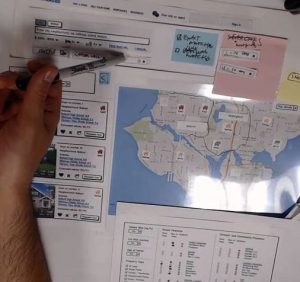| You and your team receive training and coaching to learn and practice proven user-centered design techniques that include:
|
|
 |
User Interviewing
Learn contextual inquiry, a best-practice qualitative interviewing technique for design data that reliably informs your product direction. It involves directly observing and talking with people while they conduct a work or life activity to capture the details, structure, and intents of their work. Observations are interpreted directly with interviewees to ensure there is agreement on the reasons behind their actions. This technique captures design data that is useful both for design thinking and helping to mitigate consequences from acting on untested assumptions arising from confirmation bias. For most projects, one to two dozen interviews suffice to capture the core user issues and scope of activity. |
|
|
|
 |
Capturing Interview Data
Practice team-based immersion into each user’s experience and learn how to capture notes and models that prove valuable over time to inspire new ideas as well as evaluate existing ideas and designs. After each interview, team members can share in the experience and offer their insights and ideas by meeting and listening to the interviewer’s retelling of the details. Participants capture online notes of key issues and sketch any models that illustrate important aspects of user activity. By participating in interview review sessions, team members gain a deeper, mutual understanding of your user and the issues they face. This intentional immersion in your users’ work and lives naturally leads teams to shift their conversations and ideas to an intense user focus: what are the most important problems to solve and the best ways to solve them. |
|
|
|
 |
Consolidating Interview Data
Learn how to consolidate the data captured from user interviews into models that represent common scope of activity, influences, and core issues. Experience shows that people exercise a limited set of strategies to carry out any given human activity, so you start seeing repetitive patterns of actions and issues after only a small number of contextual interviews. Consolidated models therefore can represent an entire target market or user population, even millions of people. Different kinds of models are created to represent the facets of peoples’ lives that are important to your project focus. An affinity diagram consolidates the interpretation session notes from all contextual interviews into a hierarchical chart. It reveals in an organized way the issues, pain points, unmet needs, and quality expectations across your user population. Other models represent the structure of various aspects of work and life activity such as: how tasks are completed throughout the day, collaboration with others, influence of self-identity expression, and artifacts used to support work. Your team uses the models to inspire design thinking for ways to help improve your users’ work and lives. They also can use the models to ground design discussions in the reality of users’ lives rather than guessing. |
|
|
|
 |
Ideation from User Data
Participate in team exercises to invent new ways to improve the work and lives of your users. Team members first immerse themselves in the previously created consolidated models to prime their brains with issues and ideas grounded in user reality. They identify overarching themes around which they, together, invent stories of ways to improve the work or lives of users by taking advantage of their knowledge of technology, materials, and business processes. Multiple stories are sketched as visions representing a future experience for your users, then evaluated and improved to resolve technical infeasibilities and business constraints. Product or service concepts are then elicited from the visions to be detailed and user-validated. |
|
|
|
 |
Testing Mockups of Your Ideas
Conduct interviews with real users in your target population to test your ideas. Team members take concepts from the ideation exercises and construct user-testable mockups, such as interactive paper prototypes, service concept boards, or physical models. Mockups are designed to be changeable on the fly and intentionally look unfinished, inviting the user to engage in constructive co-design of changes that can be made immediately. Team members conduct mockup interviews the same way as contextual inquiry interviews, talking to real users with the addition of manipulating the prototype as they use it to re-create their real-life activities. Review sessions are held after each interview to identify and capture design issues. After each round of interviews, typically with 3-5 users, the team maps the user issues to the design and makes changes. It typically takes two to three rounds of mockup testing to stabilize the design enough to build a more refined model such as a wireframe. |